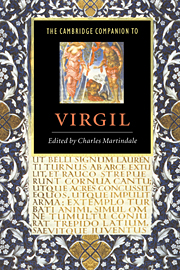Book contents
- Frontmatter
- Contents
- List of illustrations
- List of contributors
- Preface
- 1 Introduction: ‘The classic of all Europe’
- Part 1 Translation and reception
- Part 2 Genre and poetic career
- Part 3 Contexts of production
- Part 4 Contents and forms
- 16 Virgil's style
- 17 Virgilian narrative (a) Story-telling
- 17 Virgilian narrative(b) Ecphrasis
- 18 Approaching characterisation in Virgil
- 19 Sons and lovers: sexuality and gender in Virgil's poetry
- 20 Virgil and tragedy
- 21 Envoi: the death of Virgil
- Dateline compiled by Genevieve Liveley
- List of works cited
- Index
- Plates
17 Virgilian narrative(b) - Ecphrasis
from Part 4 - Contents and forms
Published online by Cambridge University Press: 28 May 2006
- Frontmatter
- Contents
- List of illustrations
- List of contributors
- Preface
- 1 Introduction: ‘The classic of all Europe’
- Part 1 Translation and reception
- Part 2 Genre and poetic career
- Part 3 Contexts of production
- Part 4 Contents and forms
- 16 Virgil's style
- 17 Virgilian narrative (a) Story-telling
- 17 Virgilian narrative(b) Ecphrasis
- 18 Approaching characterisation in Virgil
- 19 Sons and lovers: sexuality and gender in Virgil's poetry
- 20 Virgil and tragedy
- 21 Envoi: the death of Virgil
- Dateline compiled by Genevieve Liveley
- List of works cited
- Index
- Plates
Summary
In modern criticism the term 'ecphrasis' ('description') is used specifically to refer to a literary description of a work of art. In ancient criticism the term belongs to a much wider area of reference, covering both the visual force and the emotional impact of verbal art (not only poetry but historiography and rhetoric). Heroic epic, in particular, was held to be a narrative form oriented towards the production of visual effects and the re-creation of an eyewitness reaction to events. Virgil is particularly famous as a maker of impressive descriptions, including e.g. a dramatic study of a brook (G. 1.104ff.), a bold vision of monstrous snakes swimming in the Dardanelles (Aen. 2.203ff), a miniature of a tame stag (7.483ff.). Didactic hexameter and heroic epic are alike very concerned with visual impact, although with divergent emphases: didactic poetry focuses on the typical and repeatable, while heroic poetry is a narrative of striking events, traditionally geared towards the grandiose and the violent. Yet in both forms the challenge of representation is at stake: how adequate is the verbal medium to convey an impression of what is being described (whether the context requires that this be vivid and fresh, or realistic and typical, or unique and shocking)? More specifically, with regard to ecphrasis in the modern sense of a verbal re-creation of a visual work of art, verbal representation tests its own limits through a confrontation between literary description and representations in other media. In this case the verbal message will be measured both against direct perceptions of reality (or visual imagination) and against the model of the visual arts.
- Type
- Chapter
- Information
- The Cambridge Companion to Virgil , pp. 271 - 281Publisher: Cambridge University PressPrint publication year: 1997
- 37
- Cited by



